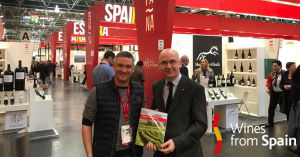BLOG
Spanish wine
Cosecha. Joven. Viejo. And the list goes on. Many wine-producing countries use local-language wine-related terminology without realizing their consumers are unaware of their meaning. Even native language speakers are sometimes confused by these terms as they are technical and/or relate to wine law.
No need to worry! Below is your very own Spanish Wine Glossary (in alphabetical order) providing the top 25 wine terms you need-to-know to navigate Spanish wine.
This article has been published in partnership with World of Fine Wine and Wine Scholar Guild.
A shocking red wine from the Jerezano new wave.
Andrew Jefford tastes 2020 Annius Atlántida Vino de la Tierra de Cádiz.
Ferran Adrià’s legendary restaurant El Bulli defined modernist cuisine. The restaurant had an undeniable influence on haute cuisine trends both in Spain and across the globe. For 13 years, its wine programme was led by sommelier Ferran Centelles. Ferran continues to work with Adrià at the elBullifoundation, a creativity centre of culinary and wine-focused scholarship that was created in 2011 after the restaurant’s closure.
Over its 42-year existence as a Denominación de Origen (DO), Ribera del Duero has transformed from a relatively unknown region to one of Spain’s most prestigious wine-producing areas.
Sherry producers like to say they deal with two types of terroir.
“First,” says Fermin Hidalgo, owner of leading Sanlúcar de Barrameda-based Bodegas Hidalgo La Gitana, “the ‘classic’ terroir we all know: climate, soil, etc. The second terroir is the one related to the wineries… Biological ageing is part of our terroir.”
In the search for a mapmaker for the Spanish Wine Scholar® program, I was somehow led to Quentin Sadler.
I didn’t think it possible to find someone with the same love and passion for Spain as I have, but I sure did in Quentin! It was obvious that our collaboration on this program was meant to be. His work is incredible and we both are committed to making this program the gold standard in Spanish wine education.
Quentin has more than 30 years in the wine trade and holds the Diploma from WSET. He is a passionate London-based wine educator, communicator, blogger, and mapmaker.
Description
Spain is one of the most amazing countries of the world and is leaving a revolution at the moment. Building on the rich heritage of Spanish viticulture, this session delves into the contemporary innovations and practices that are redefining the wine landscape in Spain. Participants will explore how traditional regions like Rioja and Ribera del Duero have embraced modern techniques and varieties to enhance their global competitiveness. The session also highlights the
Summary:
Rioja is probably Spain's most famous wine region, best known for its oak aged red wines. But Rioja is more than a classic wine of style, it can also be wine of place, coming from 144 different villages divided in 3 large subzones, including some of the best terroirs in the word.
Join us for a deep dive in the three Rioja subregions (Rioja Alta, Rioja Alavesa and Rioja Oriental) with 3
In this episode, we are chatting with Rick Fisher, Spanish Wine Scholar Education Director, about Sherry styles and getting a behind-the-scenes peek at the forthcoming Spanish Wine Scholar Program.
Summary:
Rick's Pick: University of Tarragona instructor and winemaker, Antoni Sanchez-Ortiz focuses on climate change and how viticulture must adapt in Spain’s DOQ Priorat region.
The mesoclimate determines climatic differences due to the topography of the Priorat and that give rise to local modifications or changes that can affect to more or less ample extensions. Factors that
Many wine regions in Europe like to reference their long history, typically dating the arrival of the first vineyards back to the time of the Roman legions. Viticulture in Jerez may well have an even longer history than that; it’s entirely possible that the first vines in the region were planted by the Phoenicians around the time they established the nearby port city of Cadiz in 1,110BC.
Summary:
Ribera del Duero is an up-and-coming Spanish wine region, along the Duero River in central Spain. Its signature grape Tempranillo has found its place in high-altitude plateaus in this arid and demanding region. Vineyards are found throughout the valley between 750 and 1060 m shaping the style of wine. Local winemakers are carving a name for themselves in small rural communities totally off the beaten track.
#thespanishwineguy joins the WSG team full-time
A couple of months ago we introduced you to Rick Fisher, our Program Developer for the upcoming Spanish Wine Scholar® (SWS) program. By way of reminder, Rick is part Catalan with a passion for his heritage and a desire to educate others about Spanish wine and food. In his spare time, he has authored the blog Bodega: Eat. Drink. Explore. ESPAÑA!, whose aim is to further educate readers about the amazing wines and food of Spain.Rick has enjoyed a long career in finance and, over the past few years, found himself drawn to pursuing more credentials within the wine industry (He is currently a WSET Diploma student with Napa Valley Wine Academy). As a result of his passion for Spain and the wine business, he left his finance job last week in order to devote all of his time to the creation of our Spanish Wine Scholar® program, whose expected launch is late-2018.Q1. Rick, you just made a huge personal move, giving up a 20-year career in finance – to work full-time in the wine industry, more specifically to devote all your time to the development of the SWS program. How are you feeling about that decision?
Bordeaux. Burgundy. Barolo. Rioja. Just the mere mention of any one of these wine regions conjures images of the world’s best wines all sharing the ability to age for decades. The wines of Rioja have earned their place amongst this elite group; and whilst consumer tastes may swing like a clock’s pendulum, the practice of aging wines in Rioja helps define its successful past, present, and future.
Spanish Wine Scholar® launches in October 2019 and we are excited to announce the program has been endorsed by Wines from Spain, the public face of ICEX Spain Trade & Investment government agency.
Watch Here
You can watch this video in our community space here
Summary
In this tasting video, Justin explores the incredibly versatile world of Albariño. Quite probably Spain's greatest white grape, the way that Albariño described is often shoehorned into a narrow and limited style that really feels increasingly clichéd. Here
Watch Here
You can watch this video in our community space here
Summary
Justin tastes one of the iconic producers in the Producer Guide, this time choosing Adega Algueira's Dolio 2019 from Ribeira Sacra. Learn why it's considered a modern classic, and the inspirational role Fernando González has played
Summary:
Join the leading Spanish wine association of 35 wineries known as the “Grands Crus of Spain,” Grandes Pagos de España (GPE), for an exclusive webinar with the Spanish Wine Scholar Guild.
GPE representatives Valentí Llagostera (Co-Owner & Co-Founder, Mas Doix) and Marta Santander (Director of Exports, Familia Martínez Bujanda) will discuss GPE’s mission to uphold the
Spanish red wines get a lot of press for being good values, but shopping in the Spanish wine aisle can be as daunting if you aren’t sure what grows where within the world of Spanish wines.
Many of Spain’s best red wines are labeled with the name of the wine appellation, rarely by grape variety. At its most simplistic, Spain can be divided into three “bands” for red grape varieties and wines. The Tempranillo grape variety excels in wines from central and northern Spain, Garnacha (Tinta) in wines from northeastern Spain and Monastrell in southeastern Spanish wines.
If you’ve ever felt completely overwhelmed while browsing a Spanish wine section, knowing just a few key wine names will help keep your shopping trip focused and ensure that you have the perfect wine to drink at a moment’s notice.
Spain began linking wine to “place” early on. As far back as the beginning of the 20th century, the need for wine regulations became self-evident. The country was experiencing rampant wine fraud; quality wines were being diluted with bulk wine on a regular basis.
Rioja was a leader in the charge for legislation to guarantee wine origin. In 1902, a Royal Decree defined the origin of its wines by establishing a geographical link between the name of a product and the place where it is produced. Just a little over two decades later, in 1925, the first Consejo Regulador (Regulating Council) was created in Rioja. In the years that followed, Jerez and Málaga also gained regional protection.
Page 1 of 2
- 1
- 2




















